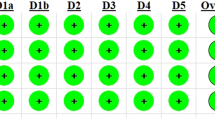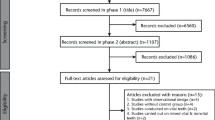Abstract
Introduction
Postoperative endodontic pain can negatively influence the quality of life of the patients. Mineral Trioxide Aggregate (MTA) has gained attention as a potential medicament in various endodontic procedures. MTA has been shown to have desirable properties such as biocompatibility, marginal adaptation, and sealing ability compared to other materials. Limited evidence is available about the effectiveness of MTA on the reduction of postoperative pain following endodontic treatment. This article aimed to compare the non-surgical post-endodontic pain-relieving effect of MTA compared with other materials.
Methods
Indexed databases (PubMed/Medline, EMBASE, OVID, Scopus, and Cochrane) were independently searched for relevant manuscripts published up to and until June 2023. Randomized controlled trials (RCTs) with a focus on teeth with pulp pathologies, with or without radiolucency, requiring primary endodontic treatment were included. Risk of bias across individual studies was performed using the Cochrane risk of bias tool for interventions.
Results
Out of the initial 169 articles searched, 9 RCTs met the selection criteria. The protocols were like all the studies, but the pain rating scales, filling material, and restoration materials varied. Out of the 9 included studies, in 4 studies MTA significantly reduced postoperative pain levels, 5 studies showed no difference between MTA and other materials, whereas 1 study reported an adverse effect of grey discoloration after MTA.
Conclusion
The findings of the present review indicate that MTA may reduce postoperative pain following non-surgical endodontic treatment. However, future standardized studies should be conducted to validate the results.
This is a preview of subscription content, access via your institution
Access options
Subscribe to this journal
Receive 4 print issues and online access
$259.00 per year
only $64.75 per issue
Buy this article
- Purchase on Springer Link
- Instant access to full article PDF
Prices may be subject to local taxes which are calculated during checkout



Similar content being viewed by others
Data availability
All data is reported in the present review.
References
Gondim E Jr, Setzer FC, Dos Carmo CB, Kim S. Postoperative pain after the application of two different irrigation devices in a prospective randomized clinical trial. J Endod. 2010;36:1295–301.
Silva EJ, Menaged K, Ajuz N, Monteiro MR, Coutinho-Filho Tde S. Postoperative pain after foraminal enlargement in anterior teeth with necrosis and apical periodontitis: a prospective and randomized clinical trial. J Endod. 2013;39:173–6.
Arslan H, Güven Y, Karataş E, Doğanay E. Effect of the simultaneous working length control during root canal preparation on postoperative pain. J Endod. 2017;43:1422–7.
Sathorn C, Parashos P, Messer H. The prevalence of postoperative pain and flare-up in single- and multiple-visit endodontic treatment: a systematic review. Int Endod J. 2008;41:91–9.
Kohli D, Falcon C, Katzmann G, Benoliel R, Khan J, Korczeniewska OA. Postendodontic pain: a practical approach to diagnosis and management. Quintessence Int. 2021;52:384–92.
Miyashita H, Worthington HV, Qualtrough A, Plasschaert A. Pulp management for caries in adults: maintaining pulp vitality. Cochrane Database Syst Rev. 2007:Cd004484. https://doi.org/10.1002/14651858.CD004484.pub2.
Arias A, de la Macorra JC, Hidalgo JJ, Azabal M. Predictive models of pain following root canal treatment: a prospective clinical study. Int Endod J. 2013;46:784–93.
Johnson BR. Considerations in the selection of a root-end filling material. Oral Surg Oral Med Oral Pathol Oral Radiol Endod. 1999;87:398–404.
Anjaneyulu K, Nivedhitha MS. Influence of calcium hydroxide on the post-treatment pain in Endodontics: a systematic review. J Conserv Dent. 2014;17:200–7.
Witherspoon DE. Vital pulp therapy with new materials: new directions and treatment perspectives-permanent teeth. Pediatr Dent. 2008;30:220–4.
Rosen E, Goldberger T, Taschieri S, Del Fabbro M, Corbella S, Tsesis I. The prognosis of altered sensation after extrusion of root canal filling materials: a systematic review of the literature. J Endod. 2016;42:873–9.
Bryan EB, Woollard G, Mitchell WC. Nonsurgical repair of furcal perforations: a literature review. Gen Dent. 1999;47:274–8.
Kratchman SI. Perforation repair and one-step apexification procedures. Dent Clin North Am. 2004;48:291–307.
Graham L, Cooper PR, Cassidy N, Nor JE, Sloan AJ, Smith AJ. The effect of calcium hydroxide on solubilisation of bio-active dentine matrix components. Biomaterials. 2006;27:2865–73.
Hilton TJ. Keys to clinical success with pulp capping: a review of the literature. Operative Dentistry. 2009;34:615–25.
Torabinejad M, Chivian N. Clinical applications of mineral trioxide aggregate. J Endod. 1999;25:197–205.
Castellucci A. The use of mineral trioxide aggregate in clinical and surgical endodontics. Dent Today. 2003;22:74–81.
Holan G, Eidelman E, Fuks AB. Long-term evaluation of pulpotomy in primary molars using mineral trioxide aggregate or formocresol. Pediatr Dent. 2005;27:129–36.
Cervino G, Laino L, D’Amico C, Russo D, Nucci L, Amoroso G, et al. Mineral trioxide aggregate applications in endodontics: a review. Eur J Dent. 2020;14:683–91.
Page MJ, McKenzie JE, Bossuyt PM, Boutron I, Hoffmann TC, Mulrow CD, et al. The PRISMA 2020 statement: an updated guideline for reporting systematic reviews. Bmj. 2021;372:n71.
Ferreira NS, Gollo EKF, Boscato N, Arias A, Silva E. Postoperative pain after root canal filling with different endodontic sealers: a randomized clinical trial. Braz Oral Res. 2020;34:e069.
Suhag K, Duhan J, Tewari S, Sangwan P. Success of direct pulp capping using mineral trioxide aggregate and calcium hydroxide in mature permanent molars with pulps exposed during carious tissue removal: 1-year follow-up. J Endod. 2019;45:840–7.
Bagheri M, Khimani H, Pishbin L, Shahabinejad H. Effect of pulpotomy procedures with mineral trioxide aggregate and dexamethasone on post-endodontic pain in patients with irreversible pulpitis: a randomized clinical trial. Eur Endod J. 2019;4:69–74.
Eghbal MJ, Haeri A, Shahravan A, Kazemi A, Moazami F, Mozayeni MA, et al. Postendodontic pain after pulpotomy or root canal treatment in mature teeth with carious pulp exposure: a multicenter randomized controlled Trial. Pain Res Manag. 2020;2020:5853412.
Kumar V, Juneja R, Duhan J, Sangwan P, Tewari S. Comparative evaluation of platelet-rich fibrin, mineral trioxide aggregate, and calcium hydroxide as pulpotomy agents in permanent molars with irreversible pulpitis: a randomized controlled trial. Contemp Clin Dent. 2016;7:512–8.
Asgary S, Eghbal MJ. Treatment outcomes of pulpotomy in permanent molars with irreversible pulpitis using biomaterials: a multi-center randomized controlled trial. Acta Odontol Scandinavica. 2013;71:130–6.
Taha NA, Al-Rawash MH, Imran ZA. Outcome of full pulpotomy in mature permanent molars using 3 calcium silicate-based materials: a parallel, double blind, randomized controlled trial. Int Endod J. 2022;55:416–29.
Kundzina R, Stangvaltaite L, Eriksen HM, Kerosuo E. Capping carious exposures in adults: a randomized controlled trial investigating mineral trioxide aggregate versus calcium hydroxide. Int Endod J. 2017;50:924–32.
Taha NA, Khazali MA. Partial pulpotomy in mature permanent teeth with clinical signs indicative of irreversible pulpitis: a randomized clinical trial. J Endod. 2017;43:1417–21.
Jeanneau C, Laurent P, Rombouts C, Giraud T, About I. Light-cured tricalcium silicate toxicity to the dental pulp. J Endod. 2017;43:2074–80.
Parirokh M, Torabinejad M, Dummer PMH. Mineral trioxide aggregate and other bioactive endodontic cements: an updated overview - part I: vital pulp therapy. Int Endod J. 2018;51:177–205.
Asgary S, Eghbal MJ, Parirokh M. Sealing ability of a novel endodontic cement as a root-end filling material. J Biomed Mater Res A. 2008;87:706–9.
Torabinejad M, Hong CU, McDonald F, Pitt Ford TR. Physical and chemical properties of a new root-end filling material. J Endod. 1995;21:349–53.
Ansari G, Ranjpour M. Mineral trioxide aggregate and formocresol pulpotomy of primary teeth: a 2-year follow-up. Int Endod J. 2010;43:413–8.
Torabinejad M, Cymerman JJ, Frankson M, Lemon RR, Maggio JD, Schilder H. Effectiveness of various medications on postoperative pain following complete instrumentation. J Endod. 1994;20:345–54.
Author information
Authors and Affiliations
Contributions
JK and MA: conceptualization, methodology, data extraction, analysis, writing, editing, supervision. JK, MA, VR, RN, LJ, and ZZ: conceptualization, data extraction, analysis, editing, writing. Correspondence and queries can be addressed to JK.
Corresponding author
Ethics declarations
Competing interests
The authors declare no competing interests.
Additional information
Publisher’s note Springer Nature remains neutral with regard to jurisdictional claims in published maps and institutional affiliations.
Rights and permissions
Springer Nature or its licensor (e.g. a society or other partner) holds exclusive rights to this article under a publishing agreement with the author(s) or other rightsholder(s); author self-archiving of the accepted manuscript version of this article is solely governed by the terms of such publishing agreement and applicable law.
About this article
Cite this article
Altuhafy, M., Ravipati, V., Nagi, R. et al. Effectiveness of mineral trioxide aggregate on postoperative pain in non-surgical endodontic treatment: a systematic review of randomized controlled trials. Evid Based Dent (2024). https://doi.org/10.1038/s41432-024-00996-7
Received:
Accepted:
Published:
DOI: https://doi.org/10.1038/s41432-024-00996-7



